
 |
Search | Index | Home | Glossary | Contact Us |
|
| |
What is Asbestos?
Asbestos is a rare, naturally occurring mineral with a chainlike crystal structure. Asbestos deposits can be found throughout the world. Deposits are still mined in Australia, Canada, South Africa, and the former Soviet Union. Asbestos is usually found mixed into other minerals. Asbestos is dangerous only if its broken crystal fibers float in the air after being disturbed.
Over the years, asbestos has had many uses. Pipe insulation, automotive brakes, shingles, wallboard, and blown-in insulation are just a few of the products that once contained asbestos. Although the federal government suspended production of most asbestos products in the early 1970s, installation of these products continued through the late 1970s and even into the early 1980s. Asbestos fibers can be released during renovations of older buildings.
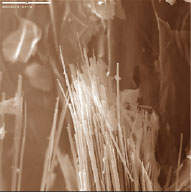 Scanning electron micrograph of asbestiform amphibole |
Nearly everyone is exposed to asbestos at some time in their lives because asbestos fibers have been frequently used in modern industry and they are also found in nature. The fibers float freely. These lightweight fibers can remain in the air for long periods of time.
The risk of developing asbestos-related illness varies with the type of industry in which the exposure occurred and with the extent of exposure.
Generally, asbestos fibers are long, thin, tough, and so small that they cannot be seen. There are two types of asbestos, one is serpentine, which looks like a corkscrew and the other is amphiboles which have long, needle-like fibers. When the fibers float in the air, they are easily inhaled. In most cases the fibers must be breathed in high concentrations over a long period of time to be considered a concern for a person's health.
Asbestos fibers can easily enter the lungs and become trapped in the lung tissues because they are so small. When these fibers are inhaled, they can penetrate and irritate the lungs. White blood cells attack the fiber, and eventually the site becomes scarred. Asbestos fibers break down extremely slowly over time. The fibers can remain in the body for many years and build up in the lungs. Because they attach to the lining of the lungs and airways, the fibers cannot be coughed out or washed out of the lung tissue. The area around the fiber becomes inflamed and, eventually, scarred. As a person's exposure to fibers increases by breathing more fibers, that person's risk of disease also increases. Diseases related to exposure to asbestos do not appear for several years, possibly 15 to 40 years after exposure.
Individuals who have been exposed (or suspect they have been exposed) to asbestos dust on the job or at home via a family contact should inform their physician of their exposure history and any symptoms. A thorough physical exam, including a chest x-ray and lung function tests, may be recommended. Interpretation of the chest x-ray may require the help of a specialist who is experienced in reading x-rays for asbestos-related illness. Other tests may be necessary.
Asbestos-Related Illnesses
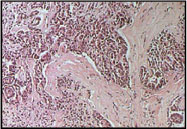 Microscopic view of mesothelioma cells |
Lung cancer is a malignant tumor that invades and obstructs the lung's air passages. Cigarette smoking greatly increases the likelihood of a person developing lung cancer as the result of asbestos exposure. The most common symptoms of lung cancer are coughing, wheezing and labored breathing. Other symptoms of lung cancer include shortness of breath, persistent chest pain, hoarseness, and anemia as well as weight loss, fever, chills and night sweats. People who develop these symptoms do not necessarily have lung cancer, but they should consult a physician for advice.
Mesothelioma is a very rare cancer of the lining of the chest or abdomen. Most mesotheliomas are caused by exposure to asbestos. By the time they are diagnosed, mesotheliomas are almost always fatal.
Asbestosis is a serious, progressive, long-term disease of the lungs that can get worse as time passes. Asbestosis is not a cancer. It is a disease that restricts how the lungs work, which makes it hard to breathe. Asbestosis is caused by inhaling asbestos fibers that irritate and inflame tissues, which creates scar tissue in the lungs. Along with scarring of the lung tissues, scarring can occur along the lining of the chest wall called the pleura. The scarring makes it hard to breathe and difficult for oxygen and carbon dioxide to pass through the lungs.
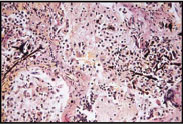 Microscopic view of of lung tissue with asbestosis |
Signs and Symptoms of asbestosis include
Asbestosis generally progresses slowly, but the rate of progress can vary greatly from one asbestos exposed person to another. The advancement of symptoms may occur even without additional exposure. It may even speed up with continued exposure. Rapid progression after the first symptoms appear is not common, but it can occur in some people. It can become increasingly difficult to breath as the symptoms progress over time. Lung tissues and the lining of the chest wall can thicken and harden from the thinness and stretchiness of a balloon to that of an orange peel.
As the disease progresses, the individual's shortness of breath becomes more pronounced. The shortness of breath is usually noted first during heavy work or exercise. It will eventually interfere with the ability to carry out everyday activities and the individual may require oxygen. The end result of progression is failure of the lungs and eventual heart failure due to the stress being placed on the heart.
The Respiratory System
The body needs oxygen to grow and function. The respiratory system is an arrangement of spaces and passageways that bring air into the lungs. These spaces include the nasal cavities; the pharynx, which is used by both the digestive tract and the respiratory system; the voice box or larynx; the trachea or windpipe; and the lungs, which include the bronchial tubes and alveoli (or air sacs).
Nasal Cavities. It is better to breathe through the nose than the mouth because (a) foreign bodies such as dust particles are filtered out by the hairs of the nostrils or caught in the surface mucus, (b) air is warmed by the blood in the vascular membrane, and (c) air is moistened by the mucus in the nasal passage.
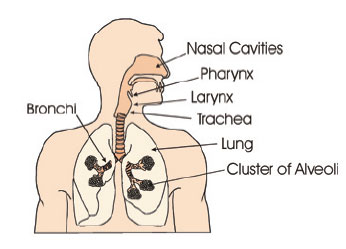 |
Pharynx. The muscular pharynx or throat carries air into the respiratory tract and also carries foods and liquids into the digestive tract.
Larynx. The larynx, or voice box, is between the pharynx and the trachea. The larynx is lined with little hairs attached to the mucous membranes. The hairs (cilia) trap dust and other particles and move them upward to the pharynx to be expelled by coughing, sneezing, or nose blowing. The cilia are the primary defense of the immune system in the respiratory tract.
Trachea. The trachea, or windpipe, is a tube that extends from the lower edge of the larynx to the upper part of the chest above the heart. The trachea has a framework of cartilage to keep it open. The trachea moves air between the larynx and the lungs.Bronchi and Bronchioles. The trachea divides into two branches (bronchi), which enter the lungs. The right bronchus is considerably larger than the left and extends downward in a more vertical direction. Each bronchus enters the lung and immediately subdivides again and again, forming smaller divisions. The smallest of the divisions are called the bronchioles.
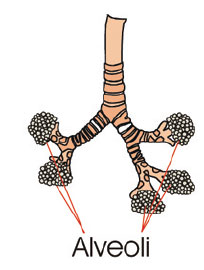 |
Alveoli. At the end of the smallest subdivisions of the bronchioles are clusters of air sacs that look like a bunch of tiny grapes. The sacs are called the alveoli. The average adult lung contains about 600 million alveoli. The exchange of oxygen and carbon dioxide in the blood takes place in the alveoli.
Oxygen-rich blood is sent to the heart, which pumps it through the body. The red blood cells carry carbon dioxide to the alveoli, and then the carbon dioxide leaves the body through exhaled breath.
Breathing that is too shallow, slow, or the result of reduced lung function is called hypoventilation. Hypoventilation results in inadequate oxygenation of the blood. Respiratory obstruction, lung disease, or exposure to toxicants can also cause this condition.
Asbestos fibers enter the body from the air we breathe. Most of the small particles we breathe— like dust and pollen—are stopped or trapped by the mucous lining and nasal hairs before entering the small airways of the lungs . Because asbestos fibers are so small and thin, they pass all the way down to the small airways and alveoli (or air sacs), where the oxygen-carbon dioxide gas exchange occurs.
The immune system, the body's defense system, considers asbestos fibers foreign invaders and tries to break them down and remove them from the lung.
Breakdown Process
Each alveolus has many cleaning cells, called macrophages, that destroy foreign invaders in the alveoli. Because asbestos fibers are too long and sharp, macrophages cannot destroy them. Macrophages then try to surround the fiber so that it cannot cause damage. In doing so, the macrophage is essentially cut open and its digestive molecules are spilled on the alveoli. This causes scar tissue to form in the spaces around the small airways and alveoli.
Scarring and thickening of the lung tissue decreases the ability of the lungs to exchange oxygen and carbon dioxide between the alveoli and the blood cells, so breathing becomes more difficult.
Treatment of Asbestos Related Illness
Unfortunately, no cure exists for asbestosis. Treatment involves preventing further complications of the disease and treating its symptoms. For information about cancer treatment, contact the National Cancer Institute's Cancer Information Service, whose toll free number is 1-800-4-CANCER.
Respiratory Infections
People with chronic lung diseases such as asbestosis are more susceptible to respiratory infections because the lungs are already damaged. One of the most important preventative measures is to produce a productive cough, or a cough that brings up mucus.
It is important to cough effectively to clear out the air passages. An effective cough is moist and brings mucus up from the lungs and air passageways. An ineffective cough reduces airflow and causes respiratory muscle fatigue. If mucus and other foreign bodies remain in the respiratory tract, they can pool in the airways, making it difficult to expel bacteria and increasing the risk of infection.
Your doctor will probably recommend a humidifier, breathing therapies, and chest percussion to ensure a productive cough. Very dry air increases shortness of breath and thickens the mucus in your lungs. These steps loosen and thin out bronchial secretions, allowing them to be expelled by the cough.
Make an effort to prevent infection. People with asbestosis should receive aggressive medical care, including frequent use of antibiotics when warranted, for any respiratory infection.
Take Care of Yourself To Prevent Infection
Keep a diary of when you have trouble breathing. Note how often you have trouble, how bad it is, and what you were doing before you had trouble. The diary will help you recognize and avoid events that trigger breathing trouble.
Stay inside, if possible, when air pollution and pollen counts are high. An air-filtering machine can improve the indoor air quality in your home.
Avoid breathing pollutants that can aggravate shortness of breath. Such pollutants include fumes from heavy traffic, smog, aerosol sprays, and products that produce chemical vapors (for example, paint, kerosene, and cleaning agents).
In cold weather, breathe through your nose and cover your mouth and nose with a scarf.
Exercise is important to increase the strength and endurance of the respiratory muscles. Increased physical activity increases respiratory muscle strength.
Drink lots of fluids—at least six glasses of water daily, unless your doctor tells you differently.
Eat healthy foods including lots of fruits and vegetables. Poor eating habits result in smaller muscle mass and are an enemy of the patient with respiratory disease.
Take measures to correct an anemic condition and/or electrolyte imbalance in your blood. Such measures could improve cardiopulmonary performance.
Watch your salt intake. Keep it low.
Breathe slowly.To lower your risk of colds or flu, wash your hands often.
Get flu and pneumonia vaccinations every year (between September and December). Caregivers and all household members, whether or not they provide care, also should be vaccinated.
Avoid situations that might expose you to respiratory infections (for example, large crowds).
Follow your doctor's instructions on taking your medicines, oxygen therapy, and/or chest physiotherapy.
Sleep 7 or 8 hours every night.
Take several short rests during the day. Learn to conserve your energy and avoid getting too tired.
Take special precautions with your personal hygiene. Wash your hands before taking your medication or handling your oxygen equipment.
Do not try to treat yourself. Over-the-counter cold remedies might worsen the problem, so do not use them unless your doctor tells you it is okay.
Have regular chest x-rays to screen for cancers associated with asbestos exposure.
Call your doctor if any of the following signs occur:
Symptoms of respiratory infections can appear suddenly and worsen quickly. When an infection develops, it is important to start treatment right away. Your doctor might prescribe antibiotics or other drugs to get the infection under control before it becomes serious. See your doctor as soon as you feel sick.
This page last updated on June 14, 2005
E-mail contact: ATSDR National Exposure
Registry
ATSDR Home | Search | Index | Glossary | Contact Us
About ATSDR | News Archive | ToxFAQs | HazDat | Public Health Assessments
Privacy Policy | External Links
Disclaimer | Accessibility
U.S.
Department of Health and Human Services